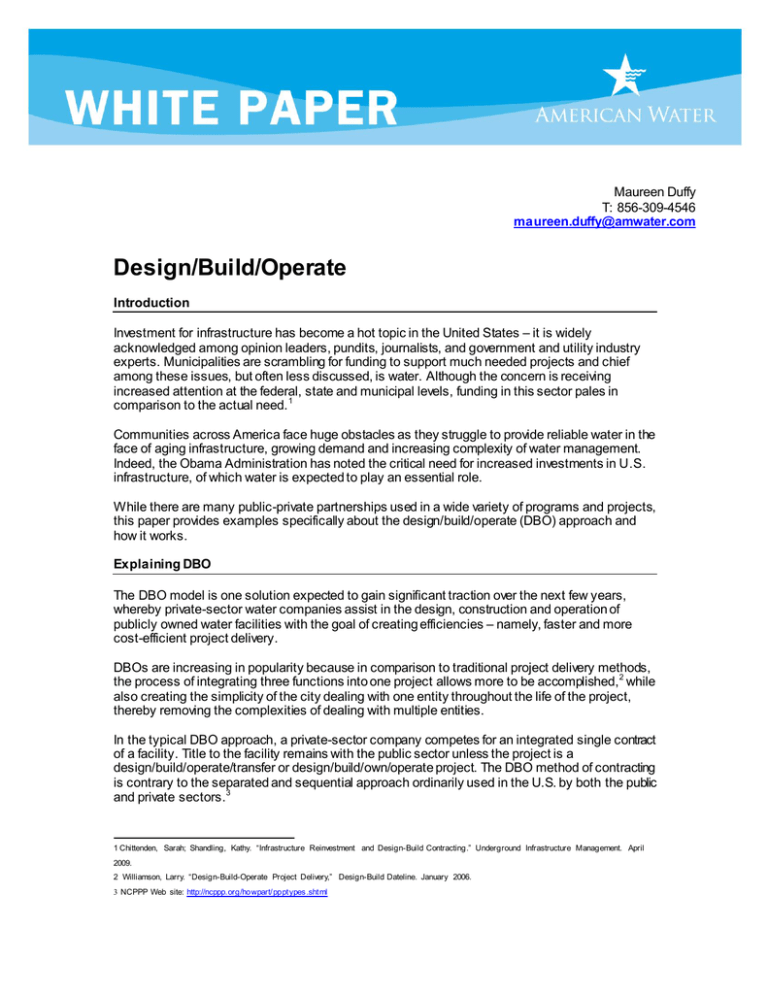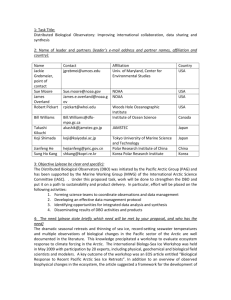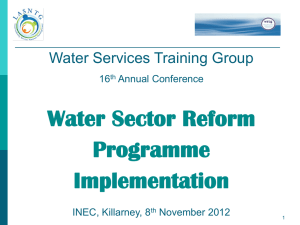Design/Build/Operate
advertisement

Maureen Duffy T: 856-309-4546 maureen.duffy@amwater.com Design/Build/Operate Introduction Investment for infrastructure has become a hot topic in the United States – it is widely acknowledged among opinion leaders, pundits, journalists, and government and utility industry experts. Municipalities are scrambling for funding to support much needed projects and chief among these issues, but often less discussed, is water. Although the concern is receiving increased attention at the federal, state and municipal levels, funding in this sector pales in comparison to the actual need. 1 Communities across America face huge obstacles as they struggle to provide reliable water in the face of aging infrastructure, growing demand and increasing complexity of water management. Indeed, the Obama Administration has noted the critical need for increased investments in U.S. infrastructure, of which water is expected to play an essential role. While there are many public-private partnerships used in a wide variety of programs and projects, this paper provides examples specifically about the design/build/operate (DBO) approach and how it works. Explaining DBO The DBO model is one solution expected to gain significant traction over the next few years, whereby private-sector water companies assist in the design, construction and operation of publicly owned water facilities with the goal of creating efficiencies – namely, faster and more cost-efficient project delivery. DBOs are increasing in popularity because in comparison to traditional project delivery methods, the process of integrating three functions into one project allows more to be accomplished, 2 while also creating the simplicity of the city dealing with one entity throughout the life of the project, thereby removing the complexities of dealing with multiple entities. In the typical DBO approach, a private-sector company competes for an integrated single contract of a facility. Title to the facility remains with the public sector unless the project is a design/build/operate/transfer or design/build/own/operate project. The DBO method of contracting is contrary to the separated and sequential approach ordinarily used in the U.S. by both the public and private sectors. 3 1 Chittenden, Sarah; Shandling, Kathy. “Infrastructure Reinvestment and Design-Build Contracting.” Underground Infrastructure Management. April 2009. 2 Williamson, Larry. “Design-Build-Operate Project Delivery,” Design-Build Dateline. January 2006. 3 NCPPP Web site: http://ncppp.org/howpart/ppptypes .shtml Design/Build/Operate A simple design/build approach creates a single point of responsibility for design and construction and can speed project completion by facilitating the overlap of the design and construction phases of the project. However, combining all three passes into a DBO approach maintains the continuity of private sector involvement and can facilitate private-sector financing of public projects supported by user fees generated during the operations phase.4 When financing is added to the project, it is secured by either the public entity, in which case it becomes a DBO with public financing, or the private-sector company, when the arrangement then becomes a design/build/finance/operate (DBFO). No matter how the project is financed, the public entity retains ownership and ultimate control. Once completed, the DBO or DBFO contractor guarantees performance and assumes the responsibilities of operations and maintenance. The benefits DBOs offer public-sector owners of water systems make for very compelling reasons to consider adopting this efficient, flexible and integrated approach to project delivery – whether building a new facility or upgrading an existing one: Lower Costs When design, construction and operation are handled together from the outset, there are more opportunities for efficiency. Research shows DBO projects are delivered at or below the owner’s budget almost twice as often as traditional DBB delivery methods. And cost savings don’t end when the construction phase is complete – decisions made during the planning process continue to gather rewards during operation. Faster Schedules Time is money, and both can be saved when many aspects of project planning, design, construction and procurement are done at the same time by the same team. All team members collaborate to help ensure an “operator-friendly” design and efficient construction process. The project timeframe can be shorter because all team members are involved from the start, with no “down time” usually associated with the transition of a project from one phase to the next in a more traditional DBB arrangement. Lower Risks In DBOs, control of the facility remains in the hands of the owner while responsibility for performance and compliance are with the DBO partner. Both the owner and DBO partner can manage risk and liability through performance guarantees, insurance, the development of maximum total project cost guarantees early on, and the implementation of quality assurance and control processes. And with the DBO partner serving as the single point of contact, management of the project by the owner is made easier. Need for DBOs Communities are faced with investing vast amounts of money, resources and expertise to renew their water systems. Even with the willingness to spend the money and access to capital, many communities lack the in-depth experience, to design and/or implement such a plan on their own. The need for partnerships in providing safe, dependable water to American communities is increasing. 5 From a business standpoint, public-private partnerships are a promising area for stable growth in the water utility sector: over 90 percent of partnership contracts are renewed annually. A source at the National Association of Water Companies is quoted in Water Policy Report: “There are 4 NCPPP Web site: http://ncppp.org/howpart/ppptypes .shtml 5 NCPPP White Paper: For the Good of the People: Using Public-Private Partnerships To Meet America’s Essential Needs. WHITE PAPER www.amwater.com Design/Build/Operate clear signs that municipal leaders are enormously satisfied with the results of these contracts.” 6 For example, in Fillmore, Calif., building upon its current successful partnership with the private sector to operate and maintain the city’s existing wastewater treatment facility, the city decided to partner again and on a much broader scale with the private sector to design, build and operate the city’s new wastewater recycling facility. The U.S. Environmental Protection Agency estimates that replacing and repairing our nation’s aging water infrastructure will cost about $335 billion over the next 20 years. Another $300 to $400 billion is needed for wastewater infrastructure. 7 With 85 percent of the nation’s water and wastewater infrastructure serviced by the public sector,8 municipalities as well as state and local governments will bear the brunt of these costs. The solution is clear: Innovation, efficiency and value must define water and wastewater projects in today’s economy to help ensure this critical work is done. American Water DBO Projects In American Water’s experience, DBO projects offer many advantages over design/bid/build (DBB), and other traditional project delivery methods. They have brought significant value to the many communities that have utilized this approach, including the following: Lake Pleasant Water Treatment Plant - Phoenix, Arizona: When the Lake Pleasant Water Treatment Plant opened in 2007, it was the largest water DBO project in North America. The $228 million plant, delivered on schedule and within budget, has a capacity of 80 million gallons per day (mgd) that will ultimately be expanded to 320 mgd to keep pace with increasing development in northern Phoenix. The city of Phoenix had considered three alternative delivery approaches for the treatment plant and raw water facilities, including DBB, Design Build and DBO. Officials ultimately selected DBO because it enabled operating staff to be involved in the design from the earliest stages, and that helped ensure a quality project with a long service life. In 2009, the U.S. Conference of Mayors recognized the project with an Outstanding Achievement in Public-Private Partnerships award. Fillmore Water Recycling Plant - Fillmore, California: Harnessing the most advanced treatment technologies available to help make a difference for the environment, American Water designed, built and now operates this state-of-the-art wastewater treatment plant that recycles 100 percent of the water it treats. The facility was built to replace an existing, outdated facility that no longer met modern environmental standards. Now, instead of water being discharged into the Santa Clara River as the old facility did, cleaner treated water suitable for irrigation is used on school grounds, in parks and green areas throughout the city of Fillmore. The plant was designed and built for maximum energy efficiency, and includes many features that allow for “greener” operation. Flow is minimized during peak hours when energy use and cost are highest. During off peak hours, a greater volume of wastewater is cycled back into the plant and treated. The DBO project helped Fillmore save $4 million by working through a single contract and establishing a guaranteed cost. Tolt Water Treatment Plant - Seattle, Washington: American Water pioneered one of the first major water DBO projects in the United States in 1997 and it continues to be a success. The Tolt Water Treatment Plant project was created out of the city of Seattle’s need to increase water supply to support growing demand and improve regulatory compliance. The city wanted to ensure the plant would perform to a standard at or above conventional public ownership and operation, but at a minimum cost within a preferred risk allocation framework. The plant provides 30 percent 6 “Cities’ Skepticism Over Privatizing Drinking Water May Be Growing.” Water Policy Report. Vol. 15, No. 12. June 12, 2006. 7 Environmental Protection Agency 2007 Drinking Water Infrastructure Needs Survey and Assessment, presented March 2009. http://www.epa.gov/ogwdw000/needssur vey/index.html. 8 The American Water White Paper: “Challenges in the Water Industry: Infrastructure and its Role in Water Supply. WHITE PAPER www.amwater.com Design/Build/Operate of Seattle’s annual water supply, generating 120 million gallons of water per day at full capacity. Innovation was a cornerstone of the plant design, with solutions such as incorporating gravity flow into the treatment process to reduce pumping costs. Occupying a smaller footprint than typical plants with similar capacity, the plant features an advanced design made possible by the collaborative nature of the DBO model. The DBO approach helped save Seattle $70 million. As one of the leading users of the DBO model in the country, American Water has used the DBO approach to deliver value and benefits to the customers and communities served in the regulated operations as well. Since December 2006, the company has been involved in 20 DBO projects totaling $328 million, including expansion projects, upgrades and new construction. Conclusion Water is one of our most essential commodities and how we choose to conserve, reuse and protect it is vital to our health and our economic growth. The infrastructure supporting the delivery of this essential product is in serious need of repair. If these challenges are to be resolved, creative solutions must be generated and new partnerships need to be forged. By being innovative and forging new ways of providing vital services, governments are proving that pubic private partnerships are a practical and viable alternative that, in many cases, maintain quality services without significant tax increases. 9 The DBO method of delivery is an effective way to implement the much needed water project in an effective and efficient manner, while also helping the U.S. overcome its water infrastructure challenges. Copyright 2013, American Water Works Company, Inc. All rights reserved. 9 NCPPP White Paper: For the Good of the People: Using Public-Private Partnerships To Meet America’s Essential Needs. WHITE PAPER www.amwater.com





